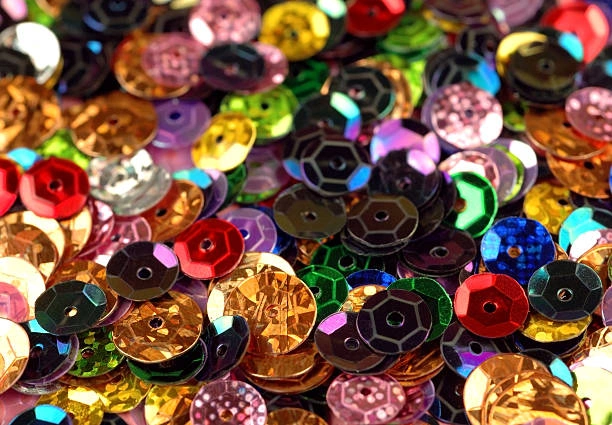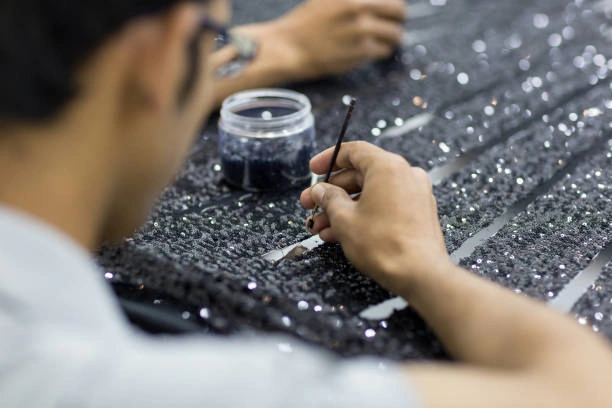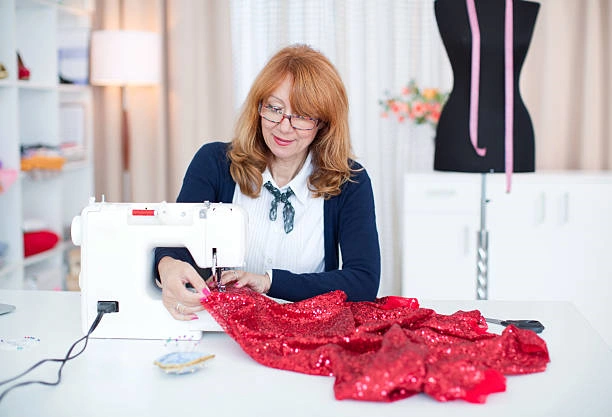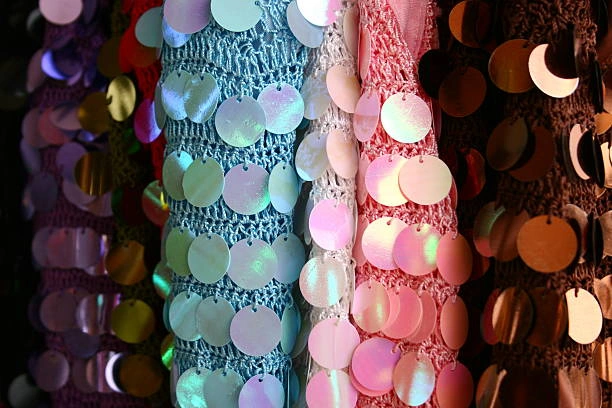Are you intimidated by those glittering sequin fabrics? Don’t be! While they might look challenging, with the right techniques, you can confidently transform these dazzling materials into stunning garments and accessories.
This comprehensive guide will equip you with the knowledge and sewing sequin fabric tips you need to tackle any sequin project, from start to finish. We’ll cover everything from preparing your fabric and choosing the right tools to mastering machine settings and tackling those tricky seams. Get ready to unlock the secrets of sewing with sequin fabric and add some serious sparkle to your wardrobe!
Essential Prep for Sequin Success

Before you even think about cutting, proper preparation is key to a smooth and successful sequin sewing experience. Taking the time to gather your materials and understand your fabric will save you headaches down the line.
Choosing Your Sequin Fabric
The world of sequin fabrics is more diverse than you might imagine, and selecting the right type for your project is crucial. You’ll encounter:
- Mesh-backed sequins: These are perhaps the most common, with sequins sewn onto a sheer mesh base. They offer good drape and are relatively easy to work with.
- Stretch sequin fabrics: Ideal for form-fitting garments like dancewear or costumes, sewing stretch sequin fabric requires specific considerations to maintain its elasticity.
- Embroidered sequins: Here, sequins are intricately stitched onto a solid fabric base, often creating patterns. These can be denser and may require more careful handling.
- Reversible sequin fabrics: These playful fabrics feature sequins that can be flipped to reveal a different color or finish. If you’re wondering, “Can you sew reversible sequin fabric?”, the answer is yes, but you’ll need to be mindful of the sequin direction during cutting and sewing to preserve the reversible effect.
Consider your project type: A flowy evening gown might suit a mesh-backed sequin, while a dance leotard would demand the flexibility of sewing stretch sequin fabric.
Gathering Your Tools & Notions
Having the right equipment on hand will make all the difference when working with sequins:
- Needles: A sharp needle is paramount to avoid snags and skipped stitches. Opt for a new sharp, microtex, or universal needle, ideally in a size 70/10 or 80/12.
- Thread: Choose a strong, good-quality polyester thread that matches your fabric or is invisible. Polyester is less likely to fray and can withstand the friction of sequins.
- Scissors: Dedicate a very sharp pair of fabric scissors solely for sequin fabric. The sequins can quickly dull blades, so avoid using your best fabric shears unless necessary, or be prepared for frequent sharpening.
- Other essentials: A thimble will protect your fingers when hand-sewing or pushing needles through dense areas. Fabric clips are often preferred over pins, as pins can get caught on or damage sequins. A tracing wheel and chalk can be useful for marking on the wrong side of the fabric.
Pre-Washing and Pressing (If Applicable)
Generally, pre-washing sequin fabrics is not recommended. The sequins or their adhesive can be sensitive to water and agitation, potentially leading to damage or detachment. Always check the care label on your specific fabric. If you must pre-wash, do so very gently by hand in cool water and air dry.
Always be careful when ironing. Use a low heat setting on your iron, always use an ironing cloth, and iron from the wrong side of the fabric to protect the sequins. High temperatures will melt plastic sequins, so avoid direct contact. If using an electronic wash, gently hand wash in cold water and air dry.
When it comes to pressing, approach with caution. Use a low heat setting on your iron, always use a press cloth, and iron from the wrong side of the fabric to protect the sequins. High heat can melt plastic sequins, so avoid direct contact.
How to Sew Sequin Fabric

Sewing sequin fabric might seem daunting, but with a strategic approach, you can achieve clean, accurate pieces for your project. This stage is crucial for ensuring your final garment hangs beautifully and seams lie flat.
Step 1: Preparing Your Fabric
Before you even pick up your scissors, proper fabric preparation is essential.
- Laying out the fabric flat: Find a large, clean, and flat surface. Carefully unroll and spread out your sequin fabric, ensuring it’s completely smooth and free of wrinkles or creases. Any unevenness at this stage will translate into distorted pattern pieces.
- Understanding the nap/direction of sequins: Most sequin fabrics have a “nap” or a specific direction in which the sequins lie. Run your hand over the fabric; it will feel smoother in one direction and rougher in the other. For consistent shimmer and drape, all your pattern pieces should be cut with the sequins facing the same direction. If you’re working with reversible sequin fabric, pay extra attention to how the sequins are facing to ensure your desired effect.
- Using fabric weights or pins strategically: Due to the weight and texture of sequins, the fabric can shift easily. Use fabric weights around your pattern pieces to hold them securely in place. If using pins, insert them carefully within the seam allowance, parallel to the cutting line, to avoid damaging or getting caught on the sequins.
Step 2: Strategic Sequin Removal (The Secret Weapon!)
This is arguably the most important sewing sequin fabric tip for successful seams. While it might seem tedious, strategic sequin removal is your “secret weapon” for smooth, flat, and comfortable seams.
- Why and when to remove sequins from seam allowances: Sewing directly over sequins can break needles, damage your machine, create bulky and uncomfortable seams, and make pressing nearly impossible. Before cutting and sewing sequin fabric, remove sequins within the seam allowance (typically 1/2 to 5/8 inch beyond your stitching line). This creates a clear path for your needle and thread.
- Techniques for careful removal without damaging the base fabric: Use small, sharp scissors or a seam ripper to carefully snip the thread holding each sequin within the seam allowance. Be meticulous to avoid cutting the base fabric. You can often flick the sequin off once the thread is snipped. This step might be time-consuming, but it is worth it for professional-looking results.
Step 3: Accurate Cutting Techniques
With your fabric prepared and sequins removed from seam allowances, you’re ready to cut.
Utilizing a rotary cutter (with caution) for long, straight lines: A rotary cutter can be effective for long, straight edges, but use it with extreme caution. The blade can be damaged by sequins if they aren’t completely cleared from the cutting path. Always use a self-healing mat underneath. For curves and intricate shapes, stick with sharp scissors. Mastering these cutting and sewing sequin fabric techniques will set you up for a smooth and dazzling sewing experience.
Using sharp scissors: As mentioned before, sharp, dedicated fabric scissors are non-negotiable. Dull blades will chew through the fabric and make for messy edges, especially when dealing with the delicate mesh base.
Single layer cutting vs. folded: For maximum accuracy and to prevent distortion, it’s often best to cut sequin fabric in a single layer. If your pattern piece requires a “cut on fold,” trace the full pattern piece onto your fabric. If you must fold, ensure the fold is perfectly aligned and secured with weights or clips.
Can You Sew Sequin Fabric With a Sewing Machine?

Yes, you can sew sequin fabric with a sewing machine, but proper preparation and techniques are key. Use a sharp, heavy-duty needle (e.g., size 90/14 sharp or denim needle) and strong thread (polyester/nylon) to pierce sequins without damage. Adjust the lower presser foot pressure to avoid crushing sequins and use a longer stitch length (2.5–3 mm) to reduce snagging. Prep the fabric by securing loose sequins with hand stitches and placing a stabilizer (tissue paper or interfacing) underneath to prevent puckering. Test on scraps first to fine-tune tension and speed.
When sewing, go slowly to avoid jams—pause to clear sequins if they accumulate under the presser foot. Stick to simple stitches like straight or narrow zigzag for seams, and avoid complex patterns that may catch on sequins. For hems, fold and pin gently, ensuring sequins don’t interfere. After sewing, trim threads carefully to avoid pulling sequins.
How to Sew Large Sequin Fabric
When working with large sequin fabrics (also known as sequin fabrics), the basic principles of sewing with sequin fabrics still apply, but certain aspects become more critical due to the increased size and bulk of the embellishments.
The most important consideration is how to remove the sequins from the seam allowance. With large sequins, sewing without breaking a needle or damaging your sewing machine is nearly impossible. You must carefully cut and remove each large sequin from the entire seam allowance, usually 1/2 to 5/8 inch beyond the intended stitch line. This provides a clear, flat path for the sewing machine needle and ensures a smooth seam.
Because large sequins make fabric bulkier, choose simpler patterns with fewer seams. This minimizes the number of sequins that need to be removed. When cutting, make sure all fabric is oriented in the same direction as the sequin pile (direction) to achieve an even sparkle. Use strong polyester thread and a sharp, sturdy needle (such as a denim needle or Microtex needle) to handle the thicker base fabrics typically used for large sequins. After sewing, you may want to hand-sew each removed sequin back onto the seam line to hide the base fabric and maintain the overall dazzling look.
Is It Difficult to Sew Sequin Fabric?

Sewing sequin fabric can be moderately challenging due to the texture and potential for snagging, but it’s far from impossible with the right approach. The main hurdles are avoiding needle breakage, preventing sequins from shedding, and ensuring even stitching. Key difficulties include dense sequins jamming the machine, delicate threads snagging, and fabric puckering.
Using a sharp needle, strong thread, stabilizers, and sewing slowly can mitigate these issues. Beginners may need practice to adjust machine settings and handle the fabric’s texture, but patience and testing on scraps make it manageable. Overall, while it requires care, sequin sewing is achievable for most skill levels with proper preparation.
Conclusion
You’ve now learned the essential techniques for sewing with sequin fabric, from careful preparation and strategic cutting to mastering machine settings and finishing touches. Don’t be afraid to experiment with these dazzling materials and create truly unique, show-stopping pieces. Let your creativity sparkle! Share your brilliant sequin projects in the comments below—we’d love to see what you’ve made with your new sewing with sequin fabric skills!
